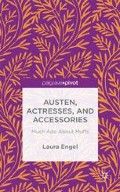Abstract
Chapter 2 looks specifically at Austens use of the muff as an accessory in Northanger Abbey and Sense and Sensibility. I argue that Austens use of the muff in these novels emphasizes the conflicts inherent infernale performance, display, and desire, central to images of muffs in portraits and satiric prints. Whereas Marianne’s muff is a representation of her unique embodiment and sexuality -one that cannot survive in the world of the novel — Mrs Allen’s desire to “guess the value” of the muff in a shop window and her obsession with fashion and the dangers of ruining her costume are about her desperation to be visible and to produce herself as a legitimate subject. I propose that representations of muffs in these novels suggest strategies for reading that emphasize the significance of the world outside of the text.
Access this chapter
Tax calculation will be finalised at checkout
Purchases are for personal use only
Preview
Unable to display preview. Download preview PDF.
Notes
Jane Austen, Northanger Abbey, eds Barbara M. Benedict and Deirdre Le Faye (Cambridge UP, 2006), 71.
Deirdre Le Faye, Jane Austens Letters. 3rd edn (Oxford and New York: Oxford University Press, 1995), 26.
Barbara M. Benedict, “The trouble with things: Objects and the commodification of sociabilty” in A Companion to Jane Austen, eds Claudia Johnson and Clara Tuite (Maiden, MA: Wiley Blackwell, 2009), 351. Tamar Wagner suggests, “Throughout Austen’s novels, shopping doubles as a defining marker of satirized society and as a metonym for changing fashions in fiction” in “ ‘Would you have us laughed out of Bath?’: Shopping around for fashion and fashionable fiction in Jane Austen adaptations” in Women, Popular Culture, and the Eighteenth-Century, ed. Tiffany Potter (Toronto: University of Toronto Press, 2012), 257.
This idea is central to Jillian Heydt-Stevenson’s excellent discussion of fashion in Northanger Abbey to which I will return later in this chapter. In Heydt-Stevenson’s Austen’s Unbecoming Conjunctions (New York: Palgrave, 2005).
See in particular Edward Copeland, Women Writing about Money: Women’s Fiction in England 1790–1820 (Cambridge UP, 1995),
David Selwyn, Jane Austen and Leisure (London: Humbledon Press, 1999),
and Maxine Berg, Luxury and Pleasure in Eighteenth-Century Britain (Oxford UP, 2005). Diego Saglia points out that according to Berg, luxury in the Romantic period was not just suggestive of vice and excessiveness but represented a more flexible concept “signifying ‘politeness, respectability, and independence’ as well as ‘modernity, refinement and pleasure, not just among the elites but among the middling classes,” in “Luxury: Making Sense of Excess in Austen’s Narratives,” in A Companion to Jane Austen, eds Claudia Johnson and Clara Tuite (Wiley Blackwell, 2009), 356. See also Benedict’s “The Trouble with Things” and Deidre Lynch’s chapter on Austen in her The Economy of Character: Novels, Market, and the Business of Inner Meaning (University of Chicago Press, 1998).
Edward Copeland, “Money,” in The Cambridge Companion to Jane Austen, eds Edward Copeland and Juliet McMaster (Cambridge UP, 2011), 132.
For an excellent discussion about reading clothes in novels and their illegibility, see Chloe Wigston Smith’s Women, Work, Clothes and the Eighteenth-Century Novel (Cambridge UP, 2013), 7
Emily Allen, Theater Figures: Production of 19th Century British Novel (Columbus: Ohio State University Press, 2003), 17
Jane Austen, Sense and Sensibility, ed. Edward Copeland (Cambridge UP, 2006), 175.
Jane Austen, Emma, eds Richard Cronin and Dorothy McMillan (Cambridge University Press, 2005), 440.
Eve Kosofsky Sedgwick, “Jane Austen and the masturbating girl,” in Critical Inquiry 17 (1991), 827
For more about the Elizas, see Bonnie G. Nelson, “Rethinking Marianne Dashwood’s very strong resemblance to Eliza Brandon” in Persuasions 34 (2012), 164–178, and Susan Greenfield, “Moving in and out: The property of self in Sense and Sensibility,” 91–100 in Claudia Johnson’s A Companion to Jane Austen.
Author information
Authors and Affiliations
Copyright information
© 2015 Laura Engel
About this chapter
Cite this chapter
Engel, L. (2015). Restless Luxuries: Muffs in Northanger Abbey and Sense and Sensibility. In: Austen, Actresses and Accessories: Much Ado About Muffs. Palgrave Macmillan, London. https://doi.org/10.1057/9781137427946_3
Download citation
DOI: https://doi.org/10.1057/9781137427946_3
Publisher Name: Palgrave Macmillan, London
Print ISBN: 978-1-349-49129-2
Online ISBN: 978-1-137-42794-6
eBook Packages: Palgrave Literature CollectionLiterature, Cultural and Media Studies (R0)

